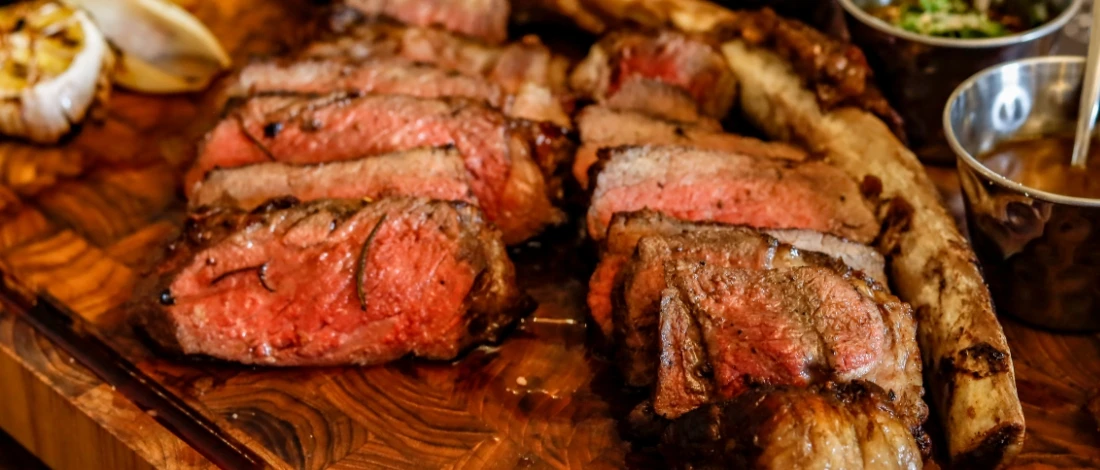As a chef with more than five years of experience, I know that getting a flavorful piece of meat starts with the correct seasoning. That’s why I go all out when it comes to seasoning my meats.
Today I'll share tips on how to season different meats like a pro because there's more to seasoning than just throwing salt and pepper on a chunk of steak.
Quick Summary
- Seasoning meat involves using the right salt, preferably kosher, and deciding on the use of pepper based on personal preference.
- Freezing seasoned meat allows it to stay fresh for longer
- Re-seasoning is a great way to adjust the flavor and taste of your ground meat
- You should try these best BBQ rubs that you can buy and spice up your natural meat flavor.
Types of Seasonings

Here are the major types of seasoning and their ingredients:
- Spicy Seasonings: All your favorite hot peppers, including cayenne, habanero, red pepper flakes, black pepper, and smoked paprika, fall under this category. Chilies help to infuse all your condiments with some smokiness and heat. This is a good taco seasoning combo.
- Saline Seasonings: Saline seasoning contains sea salt, spiced salts, and saltpeter. These salts intensify the flavor of the meat while balancing the aroma of other spices used. Also, salt acts as a preservative to keep meat fresh.
- Saccharine Seasonings: These types of seasonings are a go-to if you want a little sweetness on your meats. They comprise all your sweet ingredients like brown sugar and honey. Honey helps the meat retain its moisture, giving you a juicer cut when cooked. The sweetness also balances the tanginess of vinegar or lemon juice when cooked.
- Acid Seasonings: Acid seasonings mostly have citric juices, pineapple juice, and vinegar. These acidic liquids are used to tenderize tough cuts of meat. They do so by breaking down the meat fibers and allowing all the marinade to absorb quickly into the meat. They also add a slight tanginess to the meat.
4 Ways to Season Different Meats
Here are ways to season different meat cuts to achieve the perfect balance of flavor.
1. Beef

The first crucial step for seasoning beef is pat drying the meat. This will give you a fantastic crispy crust when you sear it on high heat.
After pat drying, use coarse kosher salt and freshly ground black pepper and massage the dry rub well throughout the meat.
For extra flavor to the rub recipe, add olive oil, paprika, onion powder, garlic, and brown sugar for some sweetness.
2. Pork
Now with pork, you need a great rub with the perfect balance between sweet, tangy, and spicy.
Begin with fully thawed pork chops and liberally season on all sides. I like to sprinkle the seasoning on the pork chops 6-8 inches above with my hands. This ensures that the seasonings are distributed evenly.
Seasoning can be done just a few minutes before barbecuing. But I recommend seasoning and allowing the meat to rest overnight before you cook it.
Also Read: Pork Red Meat
3. Chicken

Seasoning chicken with a dash of dried herbs kicks up the flavor. You can go with the quick and easy sweet, dry rub that combines all dried basil, rosemary, thyme, garlic, black pepper, and sweet paprika pepper. Rub this all-over your pat-dried chicken meat.
If you're using brine seasoning or liquid marinades made of lemon or vinegar with all other spices, place the chicken in a Ziploc bag and pour in the marinade.
Shake the bag well and let the chicken sit. If you're seasoning a whole chicken, you can use a meat injector to infuse the marinade seasoning.
4. Fish
Ideally, the secret to seasoning fish is using the right spices that'll not overpower the natural fish flavor.
If you're cooking mild fish, go easy on the seasoning and use light ingredients like simple herbs and lemon juice. But if you're cooking like tuna and salmon, you can use bold seasonings like chili powder, garlic paste, or balsamic vinegar.
"Dry the meat before seasoning because wet meat struggles to form a crispy crust and give a boiled-meat taste."
- Richard Turner, Executive Chef
Can You Season Meat Before Freezing?

Yes, you can season the meat before freezing.
Even though I'm a pre-sear seasoner myself, from time to time, especially when I buy meat in bulk, I always season it before freezing. Freezing meat keeps it fresh so you can use it in later days.
When seasoning the meat, ensure that you use little salt because too much salt can dehydrate the meat when frozen for a long time.
Another essential thing to note when seasoning meat pre-freeze is the amount of garlic you use.
Ensure you use a small amount of garlic because when the frozen garlic stays in contact with the meat for a long time, it tends to overpower other spices and the meat flavor.
Freezing meat buffers the growth of harmful bacteria in the meat, and it doesn't alter the nutritional value of the meat [1].
However, it's good to note that ice crystals that form due to low temperatures harm the meat's fiber, and this can cause some flavor seasonings to escape when you're thawing or frying on a slow cooker.
Another downside to seasoning meat and freezing it is the thawing time, especially when you're ready to cook it.
4 Tips on How to Season Meat
Here are four tips for teaching how to season your meat like a professional:
1. Use the Right Salt

You want to have salt that you can readily pinch and sprinkle. Kosher salt is my go-to for seasoning all meats because its grains are coarser than ordinary table salt.
When using table salt, it is easy to over-season. That's why it would be best to get some kosher salt for your meat seasoning.
Kosher is also easily absorbed into the meat and gives you that perfect crust.
2. Re-season Your Meat
When prepping your raw meat, it's impractical to taste and see how well-seasoned it is. You cannot tell how salty or peppery the meat is because it's raw. This is why I re-season my meat.
After cooking the meat to your desired outcome, re-season the same seasoning you used during prepping.
This allows you to add enough of what's not already there, like salt and pepper. Sometimes, you might have over-salted your meat, and when re-seasoning, you can add some water or sweet sauce to dilute the salt.
3. Shake the Bag Well

When seasoning your meat, I recommend you use a ziplock or airtight bag. After combining all your seasoning with olive oil on the meat, I recommend that you give the bag a good shake to mix everything up.
If you're using a dry rub on your steak, thoroughly massage the spices into the meat. This meat seasoning process is crucial to ensure all ingredients spread well to all the parts of the meat for an even taste in every bite.
4. A Little Spice Goes a Long Way
When it comes to meat seasoning, consider that less is always more. If you're unsure how much seasoning to use, start with a modest quantity.
It is way easier to add additional spice afterward than it is to rescue an excessively spiced dinner. You should also add one flavor at a time and use fewer other herbs to produce a superb taste.
One thing to remember while flavoring your meat is not to go crazy. Meat seasoning aims to improve the aroma of the meat rather than one spice fully overpowering the actual meat taste.
Related Articles:
Low FODMAP Steak Seasoning Recipe
The low FODMAP steak seasoning is a versatile blend of spices that enhances the flavor of meats and vegetables without using garlic or onion powder. Low FODMAP steak seasoning is suitable for those with gastrointestinal symptoms, enhancing steak flavor without causing discomfort.
Recipe Overview
- Prep Time: 5 min
- Cook Time: 0 min
- Total Time: 5 min
- Number of Servings: 24
Ingredients
- 2 Tbsp. paprika
- 1 Tbsp. salt
- 1 Tbsp. dried dill
- 1 Tbsp. dried chives
- 2 tsp. dry mustard
- 1 Tbsp. freshly ground black pepper
- 1 tsp. red pepper flakes, optional
Instructions
- In a small bowl, add and mix all ingredients together until well combined.
- Place in an airtight container and store until ready to use.
Recipe Notes
- This low FODMAP recipe makes about 24 servings. Each serving is 1/4 teaspoon.
- The red pepper flakes are not required, but add a nice bit of heat to the seasonings. If you don't like hot chili or super-spicy things, you can omit the pepper or reduce the amount used.
- This low FODMAP steak seasoning is perfect for use on any type of steak. It would also be delicious on roasted veggies or baked potatoes.
FAQs
What Seasonings Are Good For Meat?
A good dry rub recipe with pepper and herb seasonings is good for meat. You can also add onions and mustard powder for extra flavor.
How Do You Add Flavor to Meat?
You add flavor to meat by seasoning it with different spices, like when you sprinkle salt and some ground pepper.
How Long Should I Season Meat?
You should season the meat for at least 40-60 minutes before cooking. But for maximum flavor, it would be best to season it overnight and grill it the next day.
How Do You Season Beef Before Cooking?
You season beef by either massaging spicy dry rub or injecting liquid marinades into it.
Should I Season the Meat Before Cooking?
Yes, you should season the meat before cooking for extra flavor from different spices.
Reference:
- https://ask.usda.gov/s/article/Does-freezing-food-kill-bacteria&ved=








